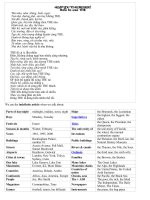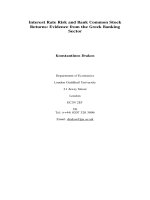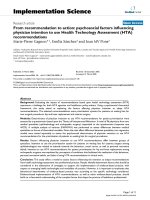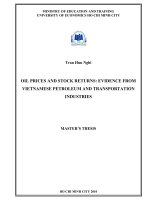Behavioral intention to use mobile stock trading , evidence from vietnams securities investors
Bạn đang xem bản rút gọn của tài liệu. Xem và tải ngay bản đầy đủ của tài liệu tại đây (513.59 KB, 79 trang )
UNIVERSITY OF ECONOMICS HO CHI MINH CITY
International School of Business
------------------------------
NGUYEN PHUC BINH
BEHAVIORAL INTENTION TO USE
MOBILE STOCK TRADING:
EVIDENCE FROM VIETNAM’S
SECURITIES INVESTORS
MASTER OF BUSINESS (Honours)
Ho Chi Minh City
UNIVERSITY OF ECONOMICS HO CHI MINH CITY
International School of Business
------------------------------
Nguyen Phuc Binh
BEHAVIORAL INTENTION TO USE
MOBILE STOCK TRADING:
EVIDENCE FROM VIETNAM’S
SECURITIES INVESTORS
ID: 22130010
MASTER OF BUSINESS (Honours)
SUPERVISOR: Dr. TRAN PHUONG THAO
Ho Chi Minh City
i
ACKNOWLEDGMENTS
Firstly, I would like to express my deepest appreciation to my supervisor Dr. Tran
Phuong Thao for her professional guidance, valuable advices, continuous
encouragement, and support that made this thesis possible.
I would like to extend deep senses of gratitude to Prof. Nguyen Dinh Tho, Dr. Tran Ha
Minh Quan, and lecturers who have taught and transferred me valuable knowledge and
experiences during my time at the International School of Business, special thanks to
all of my dear friends in Mbus4 class who gave me useful materials, responses and
experiences to conduct this study.
I would also like to express my grateful thanks to my managers, my friends, and my
colleagues who participated in filling the questionnaires and/or helped send the
questionnaires to their peers; to securities investors, and provided valuable information
and comments for this study.
Personally, I wish to express my deep gratitude to my colleagues and friends working
at Vietcombank Fund Management (VCBF); Saigon Securities Inc. (SSI); VNDirect
Securities Corporation (VND); Hochiminh City Securities Corporation (HSC);
Maybank Kim Eng Securities Limited; Mirae Asset Wealth Management Securities
(VN) JSC, and Vietcapital Securities Corporation (VCSC).
Ho Chi Minh City, Vietnam,
January 27, 2016
Nguyen Phuc Binh
ii
ABSTRACT
The purpose of this study is to investigate the determinants of securities investors
iii
TABLE OF CONTENTS
ACKNOWLEDGMETS ............................................................................................. i
ABSTRACT. .............................................................................................................. ii
TABLE OF CONTENT............................................................................................iii
LIST OF FIGURES ................................................................................................... v
LIST OF TABLES .................................................................................................... vi
LIST OF ABBREVIATIONS .................................................................................. vii
CHAPTER 1: INTRODUCTION ............................................................................. 1
1.1. Background of the study...................................................................................... 1
1.2. Research gap. ...................................................................................................... 2
1.3. Research objectives and research questions ......................................................... 4
1.4. Research methodology and research scope .......................................................... 4
1.5. Research structure ............................................................................................... 5
CHAPTER 2: LITERATURE REVIEW& HYPOTHESES DEVELOPMENT .... 6
2.1. Theoretical background ....................................................................................... 6
2.1.1. Unified Theory of Acceptance and Use of Technology (UTAUT) ....................... 6
2.1.2. The extended UTAUT. ....................................................................................... 7
2.2. Behavioral intention, risk perceptions and privacy concern. ................................ 8
2.2.1. Behavioral Intention. ........................................................................................ 8
2.2.2. Risk Perception. ................................................................................................ 9
2.2.3. Privacy Concern. .............................................................................................. 9
2.3.
Hypotheses Development................................................................................ 10
2.3.1. Hypotheses Derived From UTAUT.................................................................. 11
2.3.2. Hypotheses Derived From Risk Perceptions .................................................... 12
2.3.3. Hypotheses Derived From Privacy Concern.................................................... 13
2.4. Conceptual model.............................................................................................. 15
2.5. Chapter summary. ............................................................................................. 15
CHAPTER 3: METHODOLOGY .......................................................................... 16
3.1. Research design................................................................................................. 16
3.1.1. Research process ............................................................................................ 16
iv
3.1.2. Measurement scales. ....................................................................................... 17
3.2. Measurement refinement.
v
APPENDICES
Appendix A: List of in-depth interview participants................................................... 52
Appendix B: In-depth interview
vi
LIST OF FIGURES
Name
Figure
Page
2.1
The UTAUT model
7
2.2
Basically generalized UTAUT model of extant researches
8
2.3
Basically generalized extended UTAUT model of extant researches
8
2.4
Conceptual framework model
15
Research process
17
4.1
The saturated model (standardized)
28
4.2
SEM & path analysis
30
4.3
The research results estimated by SEM
31
3
vii
LIST OF TABLES
Name
Table
3.1
Final measurement scales
3.2
Cronbach
Page
20
viii
LIST OF ABBREVIATIONS
No.
Abbreviation
Name
1
PE
Performance expectancy
3
EE
Effort expectancy
4
SI
Social influence
5
SR
Security risk
6
FR
Functional risk
7
ER
Economic risk
8
PC
Privacy concern
9
BI
Behavioral intention
10
ICT
Information communication technology
11
UTAUT
Unified theory of acceptance and use of technology
12
TAM
Technology acceptance model
13
TFSA
Toronto Financial Services Alliance
14
SEM
Structural Equation Model
15
EFA
Exploratory Factors Analysis
16
CFA
Comfirmatory Factors Analysis
17
PDAs
Personal Digital Assistants
18
PC
Personal Computer
19
MOIT
Ministry of Industry & Trade
20
M-Trading
Mobile Stock Trading
1
CHAPTER 1: INTRODUCTION
1.1. Research Background
2
(Bakos et al., 2000). With online trading, buying or selling securities is only a single click on
a computer mouse (Li et al., 2002).
Although the Vietnamese financial market in general; and specifically the securities
market have not been significantly developed, it was categorized as an attractive emerging
market. Obviously, more and more foreign prominent financial institutions such as Citibank,
HSBC, ANZ bank, Commonwealth bank, Bank of Tokyo, Franklin Templeton, Blackhorse,
AIG, Prudential, Manulife,
3
Corp., FPT Securities Corp., MB Securities Corp., VPbank Securities Corp., BaoViet
Securities Corp., etc), even developed smart-phone-based application for its clients to
conduct securities trading everywhere. However, there are some limitations while carrying
out mobile-based transactions due to its nature (Tai & Ku, 2013) as well as careful
consideration of customers with regard to the risk assessment (Zhou, 2012), thus only few
Vietnamese securities investors actually use M-Trading. In other words, the questions on
rationales of securities investors willing or reluctant to use M-Trading and factors influencing
their behavioral intention to use M-Trading in Vietnam have received increasing concerns of
researchers.
In the literature, many prior studies on ICT
4
(TAM). Recently, the UTAUT model or extended UTAUT model have successfully
employed to explain behavioral intention to usemobile securities trading (Tai & Ku, 2013),
users
5
since investigating the behavioral intention, potential investors at the same age level will be
also invited to participate.
1.5. Research Structure
The research is divided into five chapters.
The first chapter introduces about background, research problems, research questions,
research purpose, scope of research and research structures.
The second chapter covers literature review of the previous research and shows
hypotheses, as well as the conceptual model of the research.
The third chapter presents the research process, sampling size, measurement scale,
main survey, and data analysis method.
The fourth chapter concentrates on preparation data, descriptive data, assessment
measurement scale and hypotheses testing.
The fifth chapter points out research overview, research findings, managerial
implications, research limitations and directions for future research.
6
CHAPTER 2: LITERATURE REVIEW & HYPOTHESES DEVELOPMENT
The chapter 2 is to present the theories associated with behavioral intention to use
mobile technology, the acceptance of mobile-based financial services and the models testing
the adoption of mobile technology over the world. Moreover, a conceptual model is built
resulting from the hypotheses generating from extant literature, simultaneously, its constructs
and relationship hypothesized among these constructs are also discussed.
2.1. Theoretical background
Studies on ICT users
7
expectations. Effort expectancy is similar to perceived ease of use and complexity. It is
similar to constructs included in previous models or theories, namely, perceived ease of use,
complexity, and ease of use. Social influence is similar to subjective norm. This construct
proposes that people
Performance
Expectancy
Effort
Expectancy
Behavioral
Intention
Social
Influence
Use
Behavior
Facilitating
Conditions
Gender
Age
Experience
Voluntariness
of Use
8
services, such as mobile banking (Yu, 2012), mobile wallet (Shin, 2009), mobile payment
(Kim et al., 2009), and mobile technologies (Park et al., 2007). These studies mainly focused
on employing the UTAUT or revising UTAUT by combining TAM
9
and is viewed as the antecedent of actual behavior. Consistent to all models portraying from
psychological theories, which argue that individual behavior is predictable and influenced by
individual intention, UTAUT argued and demonstrated usage intention to have significant
influence on ICT usage (Venkatesh et al., 2003; Venkatesh & Zhang, 2010).
2.2.2. Risk Perception
Concerning the acceptance of mobile-based mode in financial services, Tai & Ku
(2013) indicated that risk perceptionsare important determinant of behavioral intention.
Perceived risks are usually considered as one of the potential barriers (Chen, 2008; Luo et al.,
2010; Hsu et al., 2011). Noticeably, mobile users see risk in prospect uncertainty arising from
data input errors, software failures, connection loss, and privacy loss (Mallat et al., 2008;
Cruz et al., 2010; Koenig-Lewis et al., 2010). M-Trading is a variant of mobile-based
financial service, of which while using, the users are required to sign up with certain
information. Hence, there is an anticipated risk of exposure to opportunistic hackers who can
access their trading accounts, delete data or make unauthorized trades. As a result, investors
may elect to forgo the potential benefits of using M-Trading.
Many previous researches have found that the intention to use mobile-based financial
services is influenced by users
10
privacy concerns believe that service providers generally tend to behave opportunistically
with their personal information. Therefore, in response to a request from securities firms for
personal information, the securities traders will likely to refuse to provide personal
information (Dinev & Hart, 2006) and/or to provide incorrect personal information (Teo et
al., 2004). From the UTAUT perspective, privacy concerns are viewed as usage inhibitors
(Bansal et al., 2010). Besides, Malhotra et al. (2004) indicated that privacy concerns of
Internet users including collection, control, and awareness in addition to the general concern
and specific concern proposed by Li (2011). Previous researches evidenced that privacy
concerns significantly influences perceived risk (Zhou, 2012, Junglas et al., 2008, Bansal et
al., 2010). Moreover, privacy concerns has significant effects on user adoption of instant
messaging (Lowry et al., 2011); web-based healthcare services (Bansal et al., 2010);
electronic health records (Angst & Agarwal, 2009); software firewalls (Kumar et al., 2008);
and ubiquitous commerce (Sheng et al., 2008).
2.3. Hypothesis development
Venkatesh et al.
11
Trading
12
Effort expectancy is defined as the extent to which individuals believe that learning to
use a certain ICT system will not require significant effort (Venkatesh et al., 2003). Effort
expectancy of using M-Trading is the users
13
adoption of mobile financial services and has been suggested being the greatest challenge to
the mobile financial service provider (Luarn & Lin, 2005; Misra & Wickamasinghe, 2004;
Mallat et al., 2008). Miyazaki & Fernandez (2001) identified security risk (i.e. potential
fraud, misrepresentation) as a key concern for Internet users. Previous researches have
indicated that many people believe that they are susceptible to identity theft while using
mobile financial services (Mallat, 2007; Wessels & Drennan, 2010). Thus, the following
hypothesis is proposed:
Hypothesis 4: Securities traders perceiving high security risk in M-Trading will have
less behavioral intention to use it.
Economic risk is investors
14
disclosure may arouse investors
15
Privacy
Concerns
Performance
Expectancy
H7-
H1+
H4-
Effort
Expectancy
Social
Influence
H2+
H3+
Behavioral
Intention to use
M-Trading
Security
Risk
H8+
Economic
Risk
H9+
Functional
Risk
H10+
H5-
H6
-
Figure 2.4: Conceptual Model
2.5. Chapter summary
This chapter presents theoretical background of each concept in the model. Based on
discussion of literature review, behavioral intention to use M-Trading is affected by seven
factors, these are: performance expectancy, effort expectancy, social influence, security risk,
economic risk, functional risk and privacy concerns. Such factors are selected to build the
model because their relationship has already tested by many previous researchers through
their studies. Hence, there are ten hypotheses proposed for this research. The next chapter
will discuss methodology that used to analyze the data and test hypotheses of the research
model.









